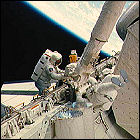 After a month of delays due to damage and a change in the flight schedule, Space Shuttle Discovery returns to orbit for a week-long flight. A Canadian communications satellite and the LEASAT-3 satellite are redeployed, but LEASAT continues to malfunction despite multiple attempts to active and launch it. Discovery’s crew on this flight consists of Commander Karol Bobko, Pilot Donald Williams, mission specialists Rhea Seddon, Jeffrey Hoffman and David Griggs, and payload specialists Charles Walker and Senator Jake Garn, the first member of the U.S. Congress to fly in space while in office. This flight’s return to the runway at Kennedy Space Center marks the first time a shuttle orbiter experiences significant damage upon landing, including a blowout of one of its landing gear wheels.
After a month of delays due to damage and a change in the flight schedule, Space Shuttle Discovery returns to orbit for a week-long flight. A Canadian communications satellite and the LEASAT-3 satellite are redeployed, but LEASAT continues to malfunction despite multiple attempts to active and launch it. Discovery’s crew on this flight consists of Commander Karol Bobko, Pilot Donald Williams, mission specialists Rhea Seddon, Jeffrey Hoffman and David Griggs, and payload specialists Charles Walker and Senator Jake Garn, the first member of the U.S. Congress to fly in space while in office. This flight’s return to the runway at Kennedy Space Center marks the first time a shuttle orbiter experiences significant damage upon landing, including a blowout of one of its landing gear wheels.

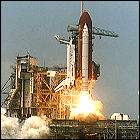 Space Shuttle Challenger lifts off on a week-long mission to perform experiments in the cargo-bay-mounted Spacelab laboratory module. Aboard Challenger for the Spacelab 3 flight are Commander Robert Overmyer, Pilot Frederick Gregory, mission specialists Don Lind, Norm Thagard, and William Thornton, and payload specialists Lodewijk van den Berg and Taylor Wang. Following the landing gear damage experienced by Discovery on its last flight, Challenger makes its landing at Edwards Air Force Base.
Space Shuttle Challenger lifts off on a week-long mission to perform experiments in the cargo-bay-mounted Spacelab laboratory module. Aboard Challenger for the Spacelab 3 flight are Commander Robert Overmyer, Pilot Frederick Gregory, mission specialists Don Lind, Norm Thagard, and William Thornton, and payload specialists Lodewijk van den Berg and Taylor Wang. Following the landing gear damage experienced by Discovery on its last flight, Challenger makes its landing at Edwards Air Force Base.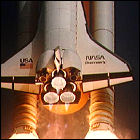 Space Shuttle Discovery returns to orbit for a week-long flight including the deployment of three communications satellites. American, Mexican and Saudi Arabian satellites are launched via payload assist modules. Discovery crew consists of Commander Daniel Brandenstein, Pilot John Creighton, mission specialists Shannon Lucid, John Fabian and Steven Nagel, and payload specialists Patrick Baudry and Sultan Salman Al-Saud (the first Saudi Arabian national to fly in space).
Space Shuttle Discovery returns to orbit for a week-long flight including the deployment of three communications satellites. American, Mexican and Saudi Arabian satellites are launched via payload assist modules. Discovery crew consists of Commander Daniel Brandenstein, Pilot John Creighton, mission specialists Shannon Lucid, John Fabian and Steven Nagel, and payload specialists Patrick Baudry and Sultan Salman Al-Saud (the first Saudi Arabian national to fly in space).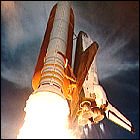 For the first and only time in the history of the shuttle program, Space Shuttle Challenger does an in-flight abort maneuver – in this case, an Abort To Orbit (ATO) following the premature shutdown of one of the shuttle’s main engines. The potentially catastrophic shutdown of a second engine is narrowly avoided by a sharp-eyed ground controller, and Challenger makes it to orbit and the rest of the mission is conducted normally.
For the first and only time in the history of the shuttle program, Space Shuttle Challenger does an in-flight abort maneuver – in this case, an Abort To Orbit (ATO) following the premature shutdown of one of the shuttle’s main engines. The potentially catastrophic shutdown of a second engine is narrowly avoided by a sharp-eyed ground controller, and Challenger makes it to orbit and the rest of the mission is conducted normally.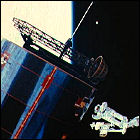 Space Shuttle Discovery lifts off on a mission to deliver three communications satellites to orbit. The triple payload includes SYNCOM IV-4, the Australian AUSSAT-1 satellite, and American Satellite Company’s ASC-1. Discovery is manned on this mission by Commander Joe Engle, Pilot Richard Covey, and mission specialists James van Hoften, John Lounge and William Fisher. The mission lasts one week, and Discovery is able to return home a day early after achieving mission objectives ahead of time.
Space Shuttle Discovery lifts off on a mission to deliver three communications satellites to orbit. The triple payload includes SYNCOM IV-4, the Australian AUSSAT-1 satellite, and American Satellite Company’s ASC-1. Discovery is manned on this mission by Commander Joe Engle, Pilot Richard Covey, and mission specialists James van Hoften, John Lounge and William Fisher. The mission lasts one week, and Discovery is able to return home a day early after achieving mission objectives ahead of time.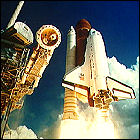 The inaugural flight of Space Shuttle Atlantis takes the newest orbiter on a four-day Defense Department mission (the specifics of which remain classified). Manning Atlantis for this flight are Commander Karol Bobko, Pilot Ronald Grabe, and mission specialists David Hilmers, Robert Stewart and William Pailes.
The inaugural flight of Space Shuttle Atlantis takes the newest orbiter on a four-day Defense Department mission (the specifics of which remain classified). Manning Atlantis for this flight are Commander Karol Bobko, Pilot Ronald Grabe, and mission specialists David Hilmers, Robert Stewart and William Pailes. With $4 billion having been spent on upgrading and customizing a special launch facility since 1972 to handle (mostly military)
With $4 billion having been spent on upgrading and customizing a special launch facility since 1972 to handle (mostly military)  Space Shuttle Challenger lifts off on a one-week mission to carry the Spacelab module and an all-German crew to orbit. The “Spacelab D1” mission is flown by Commander Henry Hartsfield, Pilot Steven Nagel, mission specialists James Buchli, Guion Bluford, and Bonnie Dunbar, and payload specialists Reinhard Furrer, Ernst Messerschmid and Wubbo J. Ockels.
Space Shuttle Challenger lifts off on a one-week mission to carry the Spacelab module and an all-German crew to orbit. The “Spacelab D1” mission is flown by Commander Henry Hartsfield, Pilot Steven Nagel, mission specialists James Buchli, Guion Bluford, and Bonnie Dunbar, and payload specialists Reinhard Furrer, Ernst Messerschmid and Wubbo J. Ockels.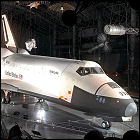 The Space Shuttle Enterprise arrives to begin its new life as a star exhibit at the Smithsonian Air & Space Museum in Washington D.C. Having used the Enterprise as a test shuttle for landings and engineering fit checks, and having dispatched it on a world tour of air shows and other public appearances, NASA donates Enterprise to the Smithsonian, as any plans to refit it into a spaceworthy orbiter have been nixed by this point.
The Space Shuttle Enterprise arrives to begin its new life as a star exhibit at the Smithsonian Air & Space Museum in Washington D.C. Having used the Enterprise as a test shuttle for landings and engineering fit checks, and having dispatched it on a world tour of air shows and other public appearances, NASA donates Enterprise to the Smithsonian, as any plans to refit it into a spaceworthy orbiter have been nixed by this point.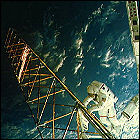 Space Shuttle Atlantis lifts off on a seven-day mission of crucial importance to plans for a future space station. In addition to launching three satellites (Mexico’s MORELOS-B, RCA’s SATCOM KU-2 and AUSSAT-2 for Australia), two spacewalks in excess of five hours each are conducted, each one testing a different method of erecting large truss structures in space. Atlantis’ crew for this mission consists of Commander Brewster Shaw, Pilot Bryan O’Connor, mission specialists Mary Cleave, Sherwood Spring, Jerry Ross and payload specialists Rodolfo Neri Vela and Charles Walker.
Space Shuttle Atlantis lifts off on a seven-day mission of crucial importance to plans for a future space station. In addition to launching three satellites (Mexico’s MORELOS-B, RCA’s SATCOM KU-2 and AUSSAT-2 for Australia), two spacewalks in excess of five hours each are conducted, each one testing a different method of erecting large truss structures in space. Atlantis’ crew for this mission consists of Commander Brewster Shaw, Pilot Bryan O’Connor, mission specialists Mary Cleave, Sherwood Spring, Jerry Ross and payload specialists Rodolfo Neri Vela and Charles Walker.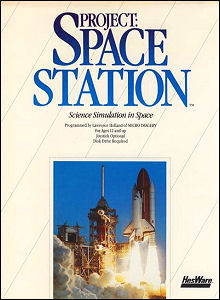 HESware releases the
HESware releases the  Space Shuttle Columbia lifts off on a six-day satellite deployment mission, and is also the first spaceflight to include a sitting member of the US Congress among its crew. The SATCOM KU-I satellite is launched, but another payload designed to observe Halley’s Comet (which is rapidly approaching its closest approach to Earth) malfunctions and collects no data. Columbia’s crew for this mission consists of Commander Robert Gibson, Pilot Charles Bolden, mission specialists Franklin Chang-Diaz, Steven Hawley, George Nelson, and payload specialists Robert Cenker and Congressman Bill Nelson.
Space Shuttle Columbia lifts off on a six-day satellite deployment mission, and is also the first spaceflight to include a sitting member of the US Congress among its crew. The SATCOM KU-I satellite is launched, but another payload designed to observe Halley’s Comet (which is rapidly approaching its closest approach to Earth) malfunctions and collects no data. Columbia’s crew for this mission consists of Commander Robert Gibson, Pilot Charles Bolden, mission specialists Franklin Chang-Diaz, Steven Hawley, George Nelson, and payload specialists Robert Cenker and Congressman Bill Nelson. 73 seconds after liftoff, Space Shuttle Challenger explodes when a rubber O-ring designed to be a tight seal between solid rocket booster segments allows flames from the booster to breach the shuttle’s external fuel tank, causing the tank’s highly flammable contents to ignite. The shuttle is destroyed with all hands aboard. Later analysis reveals that frigid cold temperatures in the nights leading up to the launch allowed the booster’s O-rings to become brittle enough to break – a possibility that NASA had been warned of by engineers at Morton-Thiokol, the contractor responsible for the solid rocket boosters.
73 seconds after liftoff, Space Shuttle Challenger explodes when a rubber O-ring designed to be a tight seal between solid rocket booster segments allows flames from the booster to breach the shuttle’s external fuel tank, causing the tank’s highly flammable contents to ignite. The shuttle is destroyed with all hands aboard. Later analysis reveals that frigid cold temperatures in the nights leading up to the launch allowed the booster’s O-rings to become brittle enough to break – a possibility that NASA had been warned of by engineers at Morton-Thiokol, the contractor responsible for the solid rocket boosters.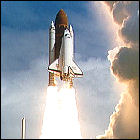 The first Space Shuttle launch in over two years since the Challenger accident, Discovery lifts off on a flight to test improved safety systems and procedures. The shuttle’s major payload is the second TDRS (Tracking & Data Relay Satellite) launched by NASA (an identical satellite was lost in the Challenger explosion in 1986), as well as numerous smaller experiments. Problems with Discovery’s environmental system cause the crew cabin to be warmer than usual. Discovery’s crew for this flight consists of Commander Fred Hauck, Pilot Richard Covey, and mission specialists John Lounge, George Nelson, and David Hilmers.
The first Space Shuttle launch in over two years since the Challenger accident, Discovery lifts off on a flight to test improved safety systems and procedures. The shuttle’s major payload is the second TDRS (Tracking & Data Relay Satellite) launched by NASA (an identical satellite was lost in the Challenger explosion in 1986), as well as numerous smaller experiments. Problems with Discovery’s environmental system cause the crew cabin to be warmer than usual. Discovery’s crew for this flight consists of Commander Fred Hauck, Pilot Richard Covey, and mission specialists John Lounge, George Nelson, and David Hilmers. 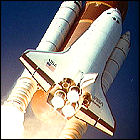 Space Shuttle Atlantis lifts off on the 27th shuttle flight, a four-day mission to launch a classified Defense Department payload. The crew aboard Atlantis for this flight consists of Commander Robert Gibson, Pilot Guy Gardner, and mission specialists Richard Mullane, Jerry Ross, and William Shepherd. All other information about this flight, including launch weight and even Atlantis’ orbital altitude, remain classified to this day.
Space Shuttle Atlantis lifts off on the 27th shuttle flight, a four-day mission to launch a classified Defense Department payload. The crew aboard Atlantis for this flight consists of Commander Robert Gibson, Pilot Guy Gardner, and mission specialists Richard Mullane, Jerry Ross, and William Shepherd. All other information about this flight, including launch weight and even Atlantis’ orbital altitude, remain classified to this day. Space Shuttle Atlantis returns to Earth from a classified four-day mission to deploy a payload for the Department of Defense, and on only the second flight since the Challenger disaster, most of Atlantis’ crew are surprised to return to Earth at all. During the mission, they note that Atlantis is missing numerous heat shield tiles along the vehicle’s right side and its wing – a post-landing damage survey counts over 700 missing tiles, making Atlantis the most-damaged orbiter to return safely from space. The damage had been pointed out to ground controllers by the crew, but when NASA asks permission from the Defense Department to allow the crew to send a live TV signal to Earth so engineers can survey the damage in orbit, that permission is refused. A slow-scan encrypted video system is used instead, and its low resolution doesn’t reveal the extent of the damage. The damage is believed to have been caused by insulation vibrating loose from the solid rocket booster and the external fuel tank and striking the shuttle during launch, an almost identical cause of damage that proves catastrophic to another shuttle 15 years later.
Space Shuttle Atlantis returns to Earth from a classified four-day mission to deploy a payload for the Department of Defense, and on only the second flight since the Challenger disaster, most of Atlantis’ crew are surprised to return to Earth at all. During the mission, they note that Atlantis is missing numerous heat shield tiles along the vehicle’s right side and its wing – a post-landing damage survey counts over 700 missing tiles, making Atlantis the most-damaged orbiter to return safely from space. The damage had been pointed out to ground controllers by the crew, but when NASA asks permission from the Defense Department to allow the crew to send a live TV signal to Earth so engineers can survey the damage in orbit, that permission is refused. A slow-scan encrypted video system is used instead, and its low resolution doesn’t reveal the extent of the damage. The damage is believed to have been caused by insulation vibrating loose from the solid rocket booster and the external fuel tank and striking the shuttle during launch, an almost identical cause of damage that proves catastrophic to another shuttle 15 years later. Space Shuttle Discovery lifts off on a nearly-five-day mission to take NASA’s third TDRS (Tracking & Data Relay Satellite) into orbit, among other smaller experiment packages, including IMAX filming. Aboard Discovery for the first shuttle flight of 1989 are Commander Michael Coats, Pilot John Blaha, and mission specialists James Bagian, James Buchli, and Robert Springer.
Space Shuttle Discovery lifts off on a nearly-five-day mission to take NASA’s third TDRS (Tracking & Data Relay Satellite) into orbit, among other smaller experiment packages, including IMAX filming. Aboard Discovery for the first shuttle flight of 1989 are Commander Michael Coats, Pilot John Blaha, and mission specialists James Bagian, James Buchli, and Robert Springer. Space Shuttle Atlantis lifts off on a four-day mission to launch the long-delayed interplanetary probe Magellan, which is sent to Venus via an Interial Upper Stage booster module. For the first time, one of a shuttle’s five onboard computers fails and is replaced in an in-orbit repair procedure. Aboard Atlantis for this flight are Commander David Walker, Pilot Ronald Grabe, and mission specialists Norm Thagard, Mary Cleave and Mark Lee. The launch of Magellan, a mission originally conceived in 1972, marks the beginning of the first American interplanetary mission since 1977.
Space Shuttle Atlantis lifts off on a four-day mission to launch the long-delayed interplanetary probe Magellan, which is sent to Venus via an Interial Upper Stage booster module. For the first time, one of a shuttle’s five onboard computers fails and is replaced in an in-orbit repair procedure. Aboard Atlantis for this flight are Commander David Walker, Pilot Ronald Grabe, and mission specialists Norm Thagard, Mary Cleave and Mark Lee. The launch of Magellan, a mission originally conceived in 1972, marks the beginning of the first American interplanetary mission since 1977. Lifting off on its first spaceflight since January 1986, Space Shuttle Columbia heads into orbit on a five-day classified Department of Defense mission. Columbia’s crew for this flight consists of Commander Brewster Shaw, Pilot Richard Richards, and mission specialists James Adamson, David Leestma and Mark Brown.
Lifting off on its first spaceflight since January 1986, Space Shuttle Columbia heads into orbit on a five-day classified Department of Defense mission. Columbia’s crew for this flight consists of Commander Brewster Shaw, Pilot Richard Richards, and mission specialists James Adamson, David Leestma and Mark Brown.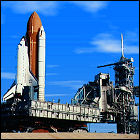 A lawsuit, filed by environmental activists worried about the release of plutonium from the Galileo Jupiter probe’s radioisotope thermoelectric generators in the event of a Challenger-like disaster during launch, is dismissed by a federal judge; the President of the United States has also given permission for the launch to proceed (a requirement anytime a nuclear-fueled spacecraft is in the works). The suit, filed earlier in the year, sought an injunction to prevent Galileo from being launched. Times have changed since the last RTG-powered flight (the Voyager missions of the 1970s), and activists are concerned about a Chernobyl-style radioactive disaster, although the plutonium 238 at the heart of Galileo’s power supply (and that of other interplanetary probes that have used it) is non-weapons-grade and non-fissible. Galileo is slated to be launched in a week aboard the space shuttle Atlantis.
A lawsuit, filed by environmental activists worried about the release of plutonium from the Galileo Jupiter probe’s radioisotope thermoelectric generators in the event of a Challenger-like disaster during launch, is dismissed by a federal judge; the President of the United States has also given permission for the launch to proceed (a requirement anytime a nuclear-fueled spacecraft is in the works). The suit, filed earlier in the year, sought an injunction to prevent Galileo from being launched. Times have changed since the last RTG-powered flight (the Voyager missions of the 1970s), and activists are concerned about a Chernobyl-style radioactive disaster, although the plutonium 238 at the heart of Galileo’s power supply (and that of other interplanetary probes that have used it) is non-weapons-grade and non-fissible. Galileo is slated to be launched in a week aboard the space shuttle Atlantis. Space Shuttle Atlantis lifts off on a mission lasting nearly five days, whose primary goal is to lift the interplanetary probe Galileo into orbit. Originally intended for launch in late 1982, Galileo is bound for Jupiter by way of a
Space Shuttle Atlantis lifts off on a mission lasting nearly five days, whose primary goal is to lift the interplanetary probe Galileo into orbit. Originally intended for launch in late 1982, Galileo is bound for Jupiter by way of a 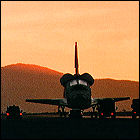 Space Shuttle Discovery lifts off on 1989’s fifth and final shuttle launch, delivering a classified Defense Department payload into orbit on a five-day mission. Aboard Discovery are Commander Frederick Gregory, Pilot John Blaha, and mission specialists Story Musgrave, Manley Carter, and Kathryn Thornton.
Space Shuttle Discovery lifts off on 1989’s fifth and final shuttle launch, delivering a classified Defense Department payload into orbit on a five-day mission. Aboard Discovery are Commander Frederick Gregory, Pilot John Blaha, and mission specialists Story Musgrave, Manley Carter, and Kathryn Thornton. Space Shuttle Columbia lifts off on a ten-day mission to deploy the LEASAT 5 communications satellite and retrieve the Long Duration Exposure Facility satellite that had been placed in orbit in 1984 by Challenger. (LDEF retrieval, delayed from 1985, had been put off by several additional years by the Challenger accident and its aftermath.) Aboard Columbia in this flight are Commander Daniel Brandenstein, Pilot James Wetherbee, and mission specialists Bonnie Dunbar, G. David Low, and Marsha Ivins.
Space Shuttle Columbia lifts off on a ten-day mission to deploy the LEASAT 5 communications satellite and retrieve the Long Duration Exposure Facility satellite that had been placed in orbit in 1984 by Challenger. (LDEF retrieval, delayed from 1985, had been put off by several additional years by the Challenger accident and its aftermath.) Aboard Columbia in this flight are Commander Daniel Brandenstein, Pilot James Wetherbee, and mission specialists Bonnie Dunbar, G. David Low, and Marsha Ivins.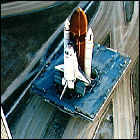 Space Shuttle Atlantis lifts off on a four-day Department of Defense mission, the specifics of which remain classified. The crew consists of Commander John Creighton, Pilot John Casper, and mission specialists Richard Mullane, David Hilmers and Pierre Thuot.
Space Shuttle Atlantis lifts off on a four-day Department of Defense mission, the specifics of which remain classified. The crew consists of Commander John Creighton, Pilot John Casper, and mission specialists Richard Mullane, David Hilmers and Pierre Thuot.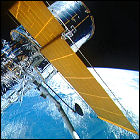 In the planning stages since the 1970s, and delayed by the post-Challenger-disaster downtime for the shuttle program, the Hubble Space Telescope is finally lifted into orbit aboard Space Shuttle Discovery. Hubble is just one of the scientific payloads for the five-day flight, with other experiments being conducted in the crew cabin and the cargo bay. Discovery’s crew for this flight is Commander Loren Shriver, Pilot Charles Bolden, and mission specialists Steven Hawley, Bruce McCandless and Kathryn Sullivan.
In the planning stages since the 1970s, and delayed by the post-Challenger-disaster downtime for the shuttle program, the Hubble Space Telescope is finally lifted into orbit aboard Space Shuttle Discovery. Hubble is just one of the scientific payloads for the five-day flight, with other experiments being conducted in the crew cabin and the cargo bay. Discovery’s crew for this flight is Commander Loren Shriver, Pilot Charles Bolden, and mission specialists Steven Hawley, Bruce McCandless and Kathryn Sullivan.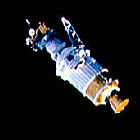 Space Shuttle Discovery lifts off to deliver another space probe whose launch has been delayed in recent years, the Ulysses mission. The remnant of a more elaborate (but ultimately scrapped) International Solar Polar mission, Ulysses is the first and only shuttle payload to use a two-stage booster to launch it from Earth orbit into a high, looping trajectory out of the plane of the ecliptic (roughly corresponding to the sun’s equator, around which the solar system’s planets orbit). Ulysses, built and managed by the European Space Agency, promises the first views of the sun’s polar regions. Discovery’s crew is Commander Richard N. Richards, Pilot Robert Cabana, and mission specialists William Shepherd, Bruce Melnick and Thomas Akers. Discovery lands at Edwards Air Force Base after four days in orbit.
Space Shuttle Discovery lifts off to deliver another space probe whose launch has been delayed in recent years, the Ulysses mission. The remnant of a more elaborate (but ultimately scrapped) International Solar Polar mission, Ulysses is the first and only shuttle payload to use a two-stage booster to launch it from Earth orbit into a high, looping trajectory out of the plane of the ecliptic (roughly corresponding to the sun’s equator, around which the solar system’s planets orbit). Ulysses, built and managed by the European Space Agency, promises the first views of the sun’s polar regions. Discovery’s crew is Commander Richard N. Richards, Pilot Robert Cabana, and mission specialists William Shepherd, Bruce Melnick and Thomas Akers. Discovery lands at Edwards Air Force Base after four days in orbit.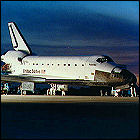 Space Shuttle Atlantis is launched on a mission involving a classified Defense Department payload, staying in Earth orbit for nearly five days. Atlantis’ crew on this flight consists of Commander Richard Covey, Pilot Frank Culbertson, and mission specialists Robert Springer, Carl Meade and Charles Gemar.
Space Shuttle Atlantis is launched on a mission involving a classified Defense Department payload, staying in Earth orbit for nearly five days. Atlantis’ crew on this flight consists of Commander Richard Covey, Pilot Frank Culbertson, and mission specialists Robert Springer, Carl Meade and Charles Gemar.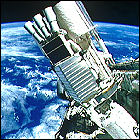 Space Shuttle Columbia lifts off for an eight-day mission to become a manned space telescope in Earth orbit, carrying the ASTRO-1 package designed to conduct X-ray and ultraviolet astronomy, mounted on an unmanned Spacelab pallet in the cargo bay. The mission has been delayed for months, most notably by hydrogen leaks detected long before the original May launch date. Manning Columbia for this flight are Commander Vance Brand, Pilot Guy Gardner, mission specialists Jeffrey Hoffman, John Lounge and Robert Parker, and payload specialists Samuel Durrance and Ronald Parise.
Space Shuttle Columbia lifts off for an eight-day mission to become a manned space telescope in Earth orbit, carrying the ASTRO-1 package designed to conduct X-ray and ultraviolet astronomy, mounted on an unmanned Spacelab pallet in the cargo bay. The mission has been delayed for months, most notably by hydrogen leaks detected long before the original May launch date. Manning Columbia for this flight are Commander Vance Brand, Pilot Guy Gardner, mission specialists Jeffrey Hoffman, John Lounge and Robert Parker, and payload specialists Samuel Durrance and Ronald Parise.  Space Shuttle Atlantis lifts off on a mission to deploy the orbiting Gamma Ray Observatory satellite. When the high-gain antenna fails to deploy on GRO, the first unplanned spacewalk since 1985 is conducted, with two of the astronauts manually releasing the antenna. Manning Atlantis for nearly six days are Commander Steven Nagel, Pilot Kenneth Cameron, and mission specialists Jerry Ross, Jay Apt and Linda Godwin.
Space Shuttle Atlantis lifts off on a mission to deploy the orbiting Gamma Ray Observatory satellite. When the high-gain antenna fails to deploy on GRO, the first unplanned spacewalk since 1985 is conducted, with two of the astronauts manually releasing the antenna. Manning Atlantis for nearly six days are Commander Steven Nagel, Pilot Kenneth Cameron, and mission specialists Jerry Ross, Jay Apt and Linda Godwin.  Space Shuttle Discovery lifts off on an eight-day mission to delivery both classified and unclassified Defense Department payloads into Earth orbit. Aboard the shuttle for this flight are Commander Michael Coats, Pilot Blaine Hammond, and mission specialists Guion Bluford, Gregory Harbaugh, Richard Hieb, Donald McMonagle and Charles Veach.
Space Shuttle Discovery lifts off on an eight-day mission to delivery both classified and unclassified Defense Department payloads into Earth orbit. Aboard the shuttle for this flight are Commander Michael Coats, Pilot Blaine Hammond, and mission specialists Guion Bluford, Gregory Harbaugh, Richard Hieb, Donald McMonagle and Charles Veach.